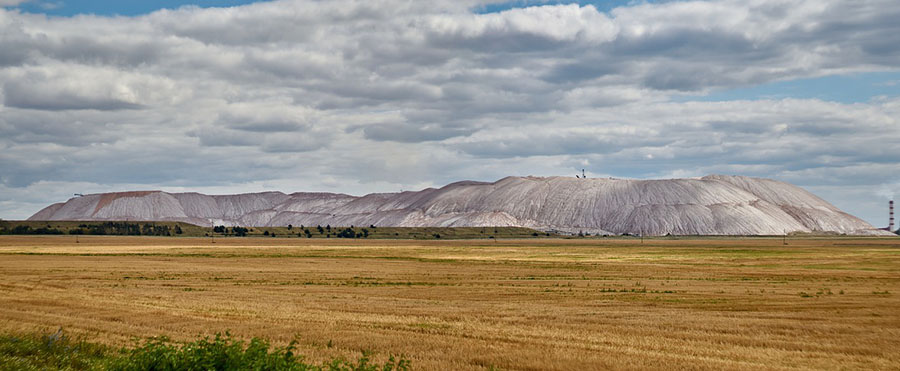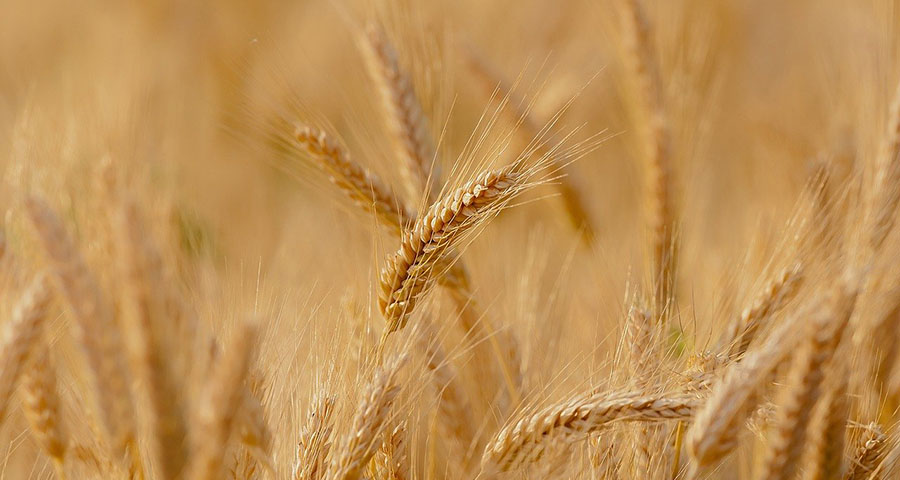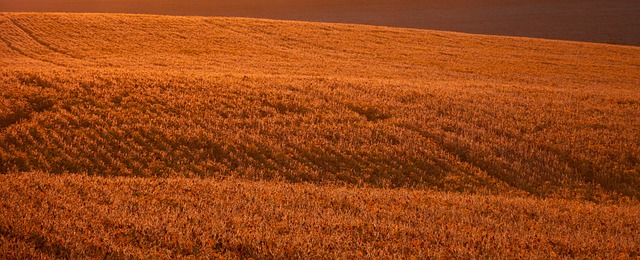Potash Supply
Source: David Coffin & Eric Coffin, HRA Advisories (3/28/11)
"Potash supply growth is critical to expanding global food output."
Cloth dying and soap making have employed residue from boiled plant material since ancient times. The plants are reduced to brine and that evaporated until only the useful "potash" remains. In the 19th century the active ingredient in this precipitate was fit into the periodic table as "potassium" with the symbol "K." Potash has stuck for potassium-bearing salts mined in modern times. The salts are processed into fertilizer, now 95% of the K market, which returns potassium to the plant world to increase agricultural yields. Potassium is irreplaceable in this application, so growth of its supply is considered critical to expand global food output. Potash salts are extracted in about a dozen areas but only a few have large scale. As with other bulk minerals, the boom in potash exploration is keyed to both greater supply diversity and more capacity.
The most important potash basin in Saskatchewan supplies about 1/3 of the market and contains half of the current reserves. Potash Corp of Saskatchewan (POT-T, N) is the region's and world's biggest potash miner, with Mosaic Co (MOS-N) and Agrium Inc (AGU-T, N) making up the balance. All of these producers market through a single agency. BHP Billiton (BHP-LSE, N.ADR) indicates it will move ahead on its Janson Lake deposit, acquired by take-over of Anglo Potash in 2008, despite a rebuff of a bid to takeover POT last year; Germany's K+S KALI is also active there (see below); and a number of other Canadian juniors own projects in the basin. These thick, rich 400-million-year-old deposits lie below 1,000 meters (3000 ft.) of cover. Most are mined from high-capital underground operations, though several use wells to circulate solutions that absorb salts.
The second-largest active basin is Upper Kama in western Russia whose largest producers, Silvinit (SLV-RTS) and Uralkali (URKA-RTS), are attempting a merger. Fertilizer giant PhosAgro has also expressed an interest in Silvinit. PhosAgro had gained Russian government approval to counter the bid by BHP for POT last year before Canadian governments nixed a take-over. The next most important potash source is the Starobin basin in Belarus being mined by a state owned firm. Russia and Belarus have joint marketing arrangements and together represent another 1/3 of potash output.
Other significant producers include: K+S KALI GmbH (K+S Group; SDF-XETRA) operating a series of German mines and which recently took over Canadian junior Potash One; Intrepid Potash (IPI-N) mining in Utah and New Mexico; Vale SA (VALE3-BOVESPA, VALE-N.ADR) from expanding mines in Brazil; ICL Fertilizers (ICL-Tel Aviv)from mines in the UK and Spain as well as solar evaporate operations in Israel; and Arab Potash (APOT-Amman) with solar evaporate operations in Jordan. These are significant producers with some room for expansion, but none approaches the scale potential of Saskatchewan or Russia/Belarus.
The Israel and Jordan operations extract potassium from Dead Sea brine. The Dead Sea is a present-day equivalent of the now dry Danakil Depression seabed on the Ethiopia/Eretria border, where potash deposits were laid down less than 2 million years ago. Danakil is generating a lot of interest. Shallow potash deposits have been located along 10s of km. of the 200 km. (120 mile) long Depression, suggesting potential for both low entry costs and significant scale.
In Ethiopia, the Indian miner Sainik Coal Mining is considering a move forward with a $1 billion potash development and BHP Billiton is at an earlier stage of assessing holdings. Smaller companies with established resources include Toronto-based juniors Allana Potash (TSX.V:AAA) and recently listed Ethiopian Potash (FED.TSX.V), both testing deposits first discovered in the 1960s. Chinese funding has begun an upgrade and expansion of Ethiopia's rail system that could move product to port facilities in Djibouti. On the Eritrean side of the boarder Australian explorer South Boulder Mines (STB-ASX) is in the early stages of outlining a resource, Vancouver's NGEx Resources (NGQ-TSX.V) from the Lundin group added potash ground to other in-country holdings, and others are showing interest. The basin is close to Eritrean port facilities on the Red Sea. Danakil means "salt lake" and it has supplied the common salt trade for millennia. It may now become important to diversifying the modern potassium salts market.
Potash Deposits and Products
Salts form as evaporation of trapped water increases its brine density. The first of the "evaporites" to drop out are halite (NaCl), the table or common salt used in spicing and preserving food, and gypsum used in construction. To generate potash salts at higher-density brine is required. Small deposits are found in a number of regions, but only a few basins have had the right conditions to both form and preserve large potash deposits.
Sylvite, KCl, is the purest potash salt with a 52.5% K content. This is one of the last salts to precipitate out of brine, so it is relatively scarce. Potassium in fertilizer is usually expressed as potassium-oxide, K2O, which is 82% K by weight; sylvite equates to 63.2% K2O. The high sylvite layer in an evaporite sequence, if it exists, is usually a mix of sylvite and halite. The more common carnallite has a K content of 14%, or 17% K2O, but carnallite ore can contain other salts that upgrade its potassium content.
The most common potash product is "muirate of potash," or MOP (muriais Latin for brine), which is potassium chloride and, therefore, chemically equivalent to sylvite. This is usually what a producer output will reference. Another typical product is potassium sulfate, K2SO4 or SOP that contains about 52% K2O but gains value as a sulfur source. Salts such as kainite containing sulfur and can be preferentially upgraded to SOP.
The USGS estimate of a global 2010 mine output at about 33 million tons (30 Mt.) is K2O equivalent. Most general comments on pricing will be based on this higher-grade form used to denote fertilizer content. Potash pricing went from a stable US $150-200/ton prior to 2007 to over $800/t in 2008 as the biofuel craze gripped markets. Post Credit Crunch pricing slumped to $300 but has recovered to near $400.
Fertilizer pricing is dependent on product form, plus the content of other nutrients that may go into various retail sales products. Potash deposits are valued on potassium content net of the costs to get that on to a loading dock in a useable form. In comparing deposits or districts it's important to note whether reporting uses K2O or KCl equivalent, or some other local notation. As with most bulk mineral commodities valuation is based on contract pricing that can be tracked through news from marketing agencies Canpotex and Belarussian Potash Co who account for over 60% of sales. Spot pricing, which is an important gauge of market sentiment, tends to trade in line with grain prices. Flooding in Australia and low precipitation in China's grain belt have been underpinning recent gains for both grains and potash.
It's a secular bull market for metals and resources. We've been saying that for 10 years. And we've been right. HRA initiated coverage on 19 companies since early 2009—the average gain to January 12, 2011 is 309%! www.hraadvisory.com
The HRA Journal, Dispatch and Special Delivery are independent publications produced and distributed by Stockwork Consulting Ltd, which is committed to providing timely and factual analysis of junior mining, resource and other venture capital companies. Companies are chosen on the basis of a speculative potential for significant upside gains resulting from asset-base expansion. These are generally high-risk securities and opinions contained herein are time and market sensitive. No statement or expression of opinion or any other matter herein, directly or indirectly, is an offer, solicitation or recommendation to buy or sell any securities mentioned. While we believe all sources of information to be factual and reliable and, in no way, do we neither represent, nor guarantee the accuracy thereof, nor of the statements made herein. We do not receive or request compensation in any form in order to feature companies in these publications. We may, or may not, own securities and/or options to acquire securities of the companies mentioned herein. This document is protected by the copyright laws of Canada and the U.S. and may not be reproduced in any form for other than for personal use without the prior written consent of the publisher. This document may be quoted, in context, provided proper credit is given.
©2010 Stockwork Consulting Ltd. All Rights Reserved.
Published by Stockwork Consulting Ltd.
P.O. Box 85909
Phoenix AZ 85071
Toll-Free 1-877-528-3958
hra@publishers-mgmt.com
http://www.hraadvisory.com
The most important potash basin in Saskatchewan supplies about 1/3 of the market and contains half of the current reserves. Potash Corp of Saskatchewan (POT-T, N) is the region's and world's biggest potash miner, with Mosaic Co (MOS-N) and Agrium Inc (AGU-T, N) making up the balance. All of these producers market through a single agency. BHP Billiton (BHP-LSE, N.ADR) indicates it will move ahead on its Janson Lake deposit, acquired by take-over of Anglo Potash in 2008, despite a rebuff of a bid to takeover POT last year; Germany's K+S KALI is also active there (see below); and a number of other Canadian juniors own projects in the basin. These thick, rich 400-million-year-old deposits lie below 1,000 meters (3000 ft.) of cover. Most are mined from high-capital underground operations, though several use wells to circulate solutions that absorb salts.
The second-largest active basin is Upper Kama in western Russia whose largest producers, Silvinit (SLV-RTS) and Uralkali (URKA-RTS), are attempting a merger. Fertilizer giant PhosAgro has also expressed an interest in Silvinit. PhosAgro had gained Russian government approval to counter the bid by BHP for POT last year before Canadian governments nixed a take-over. The next most important potash source is the Starobin basin in Belarus being mined by a state owned firm. Russia and Belarus have joint marketing arrangements and together represent another 1/3 of potash output.
Other significant producers include: K+S KALI GmbH (K+S Group; SDF-XETRA) operating a series of German mines and which recently took over Canadian junior Potash One; Intrepid Potash (IPI-N) mining in Utah and New Mexico; Vale SA (VALE3-BOVESPA, VALE-N.ADR) from expanding mines in Brazil; ICL Fertilizers (ICL-Tel Aviv)from mines in the UK and Spain as well as solar evaporate operations in Israel; and Arab Potash (APOT-Amman) with solar evaporate operations in Jordan. These are significant producers with some room for expansion, but none approaches the scale potential of Saskatchewan or Russia/Belarus.
The Israel and Jordan operations extract potassium from Dead Sea brine. The Dead Sea is a present-day equivalent of the now dry Danakil Depression seabed on the Ethiopia/Eretria border, where potash deposits were laid down less than 2 million years ago. Danakil is generating a lot of interest. Shallow potash deposits have been located along 10s of km. of the 200 km. (120 mile) long Depression, suggesting potential for both low entry costs and significant scale.
In Ethiopia, the Indian miner Sainik Coal Mining is considering a move forward with a $1 billion potash development and BHP Billiton is at an earlier stage of assessing holdings. Smaller companies with established resources include Toronto-based juniors Allana Potash (TSX.V:AAA) and recently listed Ethiopian Potash (FED.TSX.V), both testing deposits first discovered in the 1960s. Chinese funding has begun an upgrade and expansion of Ethiopia's rail system that could move product to port facilities in Djibouti. On the Eritrean side of the boarder Australian explorer South Boulder Mines (STB-ASX) is in the early stages of outlining a resource, Vancouver's NGEx Resources (NGQ-TSX.V) from the Lundin group added potash ground to other in-country holdings, and others are showing interest. The basin is close to Eritrean port facilities on the Red Sea. Danakil means "salt lake" and it has supplied the common salt trade for millennia. It may now become important to diversifying the modern potassium salts market.
Potash Deposits and Products
Salts form as evaporation of trapped water increases its brine density. The first of the "evaporites" to drop out are halite (NaCl), the table or common salt used in spicing and preserving food, and gypsum used in construction. To generate potash salts at higher-density brine is required. Small deposits are found in a number of regions, but only a few basins have had the right conditions to both form and preserve large potash deposits.
Sylvite, KCl, is the purest potash salt with a 52.5% K content. This is one of the last salts to precipitate out of brine, so it is relatively scarce. Potassium in fertilizer is usually expressed as potassium-oxide, K2O, which is 82% K by weight; sylvite equates to 63.2% K2O. The high sylvite layer in an evaporite sequence, if it exists, is usually a mix of sylvite and halite. The more common carnallite has a K content of 14%, or 17% K2O, but carnallite ore can contain other salts that upgrade its potassium content.
The most common potash product is "muirate of potash," or MOP (muriais Latin for brine), which is potassium chloride and, therefore, chemically equivalent to sylvite. This is usually what a producer output will reference. Another typical product is potassium sulfate, K2SO4 or SOP that contains about 52% K2O but gains value as a sulfur source. Salts such as kainite containing sulfur and can be preferentially upgraded to SOP.
The USGS estimate of a global 2010 mine output at about 33 million tons (30 Mt.) is K2O equivalent. Most general comments on pricing will be based on this higher-grade form used to denote fertilizer content. Potash pricing went from a stable US $150-200/ton prior to 2007 to over $800/t in 2008 as the biofuel craze gripped markets. Post Credit Crunch pricing slumped to $300 but has recovered to near $400.
Fertilizer pricing is dependent on product form, plus the content of other nutrients that may go into various retail sales products. Potash deposits are valued on potassium content net of the costs to get that on to a loading dock in a useable form. In comparing deposits or districts it's important to note whether reporting uses K2O or KCl equivalent, or some other local notation. As with most bulk mineral commodities valuation is based on contract pricing that can be tracked through news from marketing agencies Canpotex and Belarussian Potash Co who account for over 60% of sales. Spot pricing, which is an important gauge of market sentiment, tends to trade in line with grain prices. Flooding in Australia and low precipitation in China's grain belt have been underpinning recent gains for both grains and potash.
It's a secular bull market for metals and resources. We've been saying that for 10 years. And we've been right. HRA initiated coverage on 19 companies since early 2009—the average gain to January 12, 2011 is 309%! www.hraadvisory.com
The HRA Journal, Dispatch and Special Delivery are independent publications produced and distributed by Stockwork Consulting Ltd, which is committed to providing timely and factual analysis of junior mining, resource and other venture capital companies. Companies are chosen on the basis of a speculative potential for significant upside gains resulting from asset-base expansion. These are generally high-risk securities and opinions contained herein are time and market sensitive. No statement or expression of opinion or any other matter herein, directly or indirectly, is an offer, solicitation or recommendation to buy or sell any securities mentioned. While we believe all sources of information to be factual and reliable and, in no way, do we neither represent, nor guarantee the accuracy thereof, nor of the statements made herein. We do not receive or request compensation in any form in order to feature companies in these publications. We may, or may not, own securities and/or options to acquire securities of the companies mentioned herein. This document is protected by the copyright laws of Canada and the U.S. and may not be reproduced in any form for other than for personal use without the prior written consent of the publisher. This document may be quoted, in context, provided proper credit is given.
©2010 Stockwork Consulting Ltd. All Rights Reserved.
Published by Stockwork Consulting Ltd.
P.O. Box 85909
Phoenix AZ 85071
Toll-Free 1-877-528-3958
hra@publishers-mgmt.com
http://www.hraadvisory.com


























































